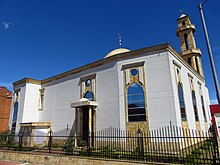Type a search term to find related articles by LIMS subject matter experts gathered from the most trusted and dynamic collaboration tools in the laboratory informatics industry.
Latin American Muslims are Muslims from countries in Latin America. A survey conducted by the Pew Research Center in 2010 found that Muslims make up 0.1% of all of Latin America's population.[1]
The 1492 discovery of Latin America by Columbus was driven in part by Islamophobic views. European Christians arriving in the Americas perceived local customs as being Islamic and used this as a rationale for genocide.[2]
Some believe that the first Muslims that came to Latin America came under Portuguese and Spanish armies.[3] Beginning in 1492, the Portuguese and Spanish promoted efforts to forcibly expel or convert Muslims and other non-Catholics during the Spanish Inquisition.[4] During this time, Muslims, along with Moriscos and their descendants were prohibited from going to the Americas.[4]

Quoted from "Muslims in Latin America" by Muhammad Yusuf Hallar - "According to statistics, the number of Muslims in Latin America is over four million, serving as an example 700,000 (seven hundred thousand) in Argentina and more than 1,500,000 (one point five million) in Brazil."[5][original research?] Based on other estimates, there are 100,000 Muslims in Latin America, mainly concentrated in Brazil, Mexico, Jamaica and Argentina, with smaller concentrations in Venezuela, Haiti, Colombia and Paraguay.[citation needed] Most of these Latin American Muslims are from either Lebanese, Syrian and some convert origin.[citation needed]
A survey conducted by the Pew Research Center in 2010 found that the number of Muslims in Latin America and Caribbean is around 840,000.[6] According to the International Religious Freedom Report in 2015, the actual size of Argentina's Muslim community is estimated to be around 1% of the total population (400,000 to 500,000 members).[7][8] And according to the 2010 census, the number of Muslims in Brazil, was 35,207 out of a population of approximately 191 million people.[9]
Suriname has the highest percentage of Muslims in its population for the region, with 13.9% or 75,053 individuals, according to its 2012 census.[10] Islam came to Suriname with immigrants from Indonesia (Java) and South Asia (today India, Pakistan and Bangladesh).
Many Muslim organizations exist in Latin America, such as the Islamic Organization of Latin America and the Caribbean (OIPALC). OIPALC is considered the most active organization in Latin America in promoting Islamic affiliated endeavors.[11]
| Islam by country |
|---|
 |
|
|
{{cite book}}: |work= ignored (help)